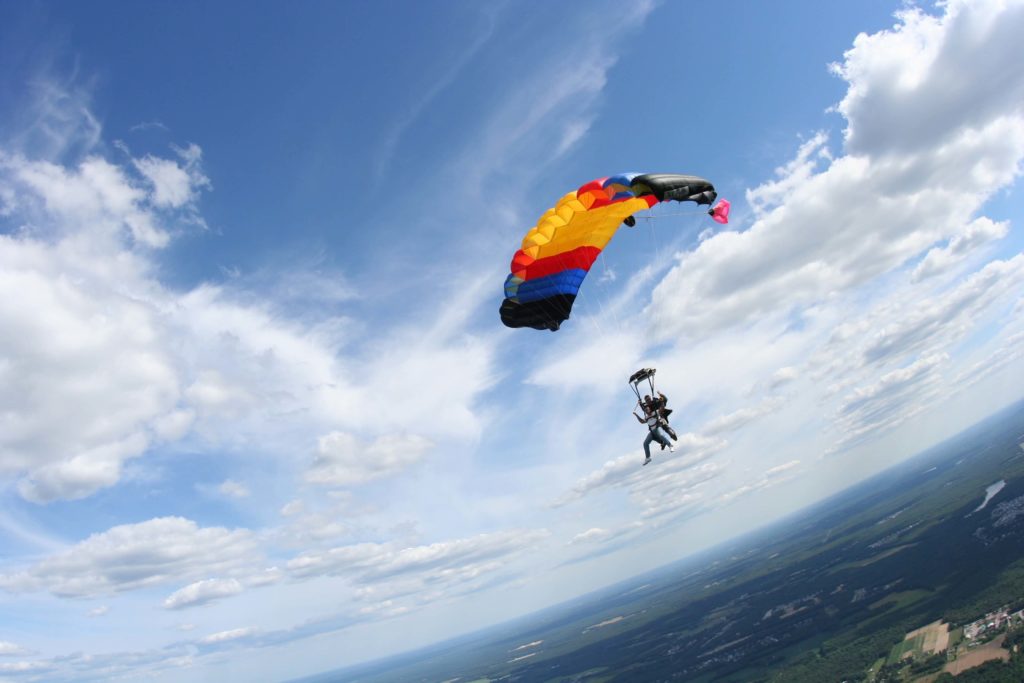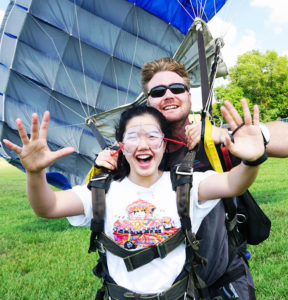How Does a Parachute Work When Skydiving?

If you’re a thrill-seeker who’s been bitten by the adventure bug, chances are you’ve considered taking the leap into parachute jumping – or, as it’s more commonly known, skydiving. Picture this: you’re soaring through the open sky, wind rushing past you, heart pounding with excitement … but there’s an important step after freefall, isn’t there?
Yep. The parachute part.
If you’ve gotten this far, you must be wondering: how does a parachute work when you’re hurtling towards the Earth?
Check it out: we’re about to unveil the magic behind safe descents, the mechanics of parachute opening and the hootin’, hollerin’ experience of canopy flight. So, get strapped in by one of our tandem parachute jump instructors and delve into the world of parachute jumping. We’ll answer all of your burning questions along the way.
Is Parachuting the Same as Skydiving?
Let’s clear up the terminology right from the start: parachuting and skydiving are essentially the same thing. “Parachuting” isn’t a term any of us regularly use – honestly, it sounds straight outta 1960’s-era TV – but, in a technical sense, it’s synonymous with “skydiving.”
Whether you go full grandpa and call it a parachute jump or flash your modern sensibility and call it a skydive, you’re in for an unforgettable adventure that involves jumping from an aircraft and descending back to solid ground.
How Does a Parachute Work?

Ready for the nitty-gritty on how parachutes work? Cool. Imagine you and your tandem instructor have taken the plunge from an aircraft, and now you’re freefalling at terminal velocity. Whee!
At the right altitude, your instructor will deploy your shared main parachute. That parachute – which we call a “canopy” – is an engineering marvel designed to slow down your descent by creating air resistance. It essentially catches the wind in a sail that gently eases you from terminal velocity (~120 mph) to a more manageable speed of descent for landing (~15 mph).
How Does a Parachute Open?
When your instructor pulls a handle to initiate the parachute deployment, a sequence of events is set in motion that’s, well, pretty cool from a mechanical perspective. Most modern parachutes use a deployment system that releases the main parachute in two stages.
Stage 1: Drogue Parachute Deployment
Soon after you and your instructor leave the plane for your triumphant tandem parachute jump, they’ll deploy a “drogue” parachute (which looks like a small, round parachute). The drogue slows you down and stabilizes your fall, making the next step safer.
Stage 2: Main Parachute Deployment
At the right altitude, the instructor releases the main parachute, which systematically unfurls and catches the air, transforming your plummet into a controlled glide.
Do Skydiving Parachutes Automatically Open?
Now, you might be wondering about those heart-pounding moments of uncertainty. What if you freeze up and forget to pull the parachute?
Enter the Automatic Activation Device (AAD). This ingenious piece of technology acts as a safety net. If it senses that you and your instructor are approaching a dangerously low altitude in the notable absence of a deployed parachute, it takes the reins and deploys the reserve parachute, just in case.
What Happens If Your Parachute Doesn’t Open When Skydiving?
Let’s address the elephant in the sky: what if, against all odds, the parachute just … doesn’t open?
First and foremost, the chances of this happening are incomprehensibly rare due to many dozens of rigorous safety protocols and redundant systems that cover all the parts of a parachute.
However, in the unlikely event that the main parachute fails to deploy properly, there is a backup parachute ready to come to your rescue, which is meticulously inspected and maintained to be a reliable Plan B for any sport skydiver or tandem pair.
How Does a Parachute Slow a Falling Person Down?
You might be curious about the science behind how a parachute slows your descent. Interestingly, it does much more than that!
Modern parachutes (that is: the more-or-less rectangular version that has taken the place of the venerable old ‘round’) do more than their predecessors, which worked simply by increasing air resistance. These nylon wonders are composed of two layers of material which are sectioned from front to back into long “cells.” Each cell has an opening on the front end of the parachute that is sealed shut at the back.
As the open parachute moves on a forward-and-down trajectory through the sky, each of these cells inflates. The inflated cells stiffen the parachute and give it a shape and capability not unlike an airplane wing. In essence, the faster-moving air that flows over the top of the resulting shape results in a differential that generates lift. With that lift engaged, the skydiver is able not only to control their descent to the ground, but also to perform a suite of maneuvers if they choose to.
How Do Parachuters Know When to Open a Parachute?
Student and licensed skydivers use altimeters to determine the right moment to deploy the parachute. An altimeter is a device that measures altitude above a reference point that we set on the ground.
Before the jump, your instructor will set a specific altitude for parachute deployment; as you fall, you might be able to watch as that altimeter provides real-time information about your altitude. This gives your instructor the information they need to pull the parachute at the optimal height for a slow descent.
The next time you’re contemplating taking the leap, remember that a parachute isn’t just a fabric contraption – it’s your ticket to gravity-defiance and mind-expansion! Whether you call it a parachute jump or a skydive, it’s time to embrace the challenge. Join us for a jump today!
